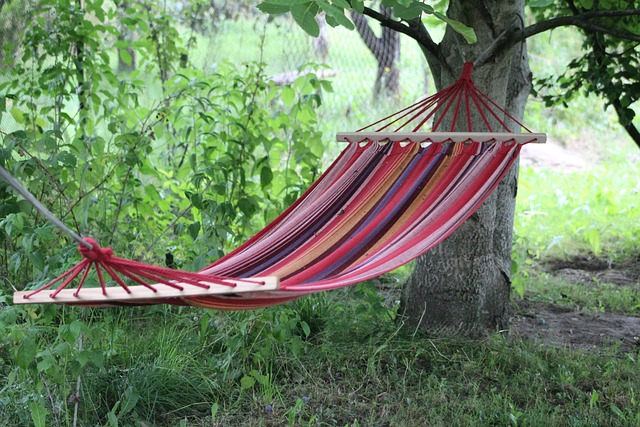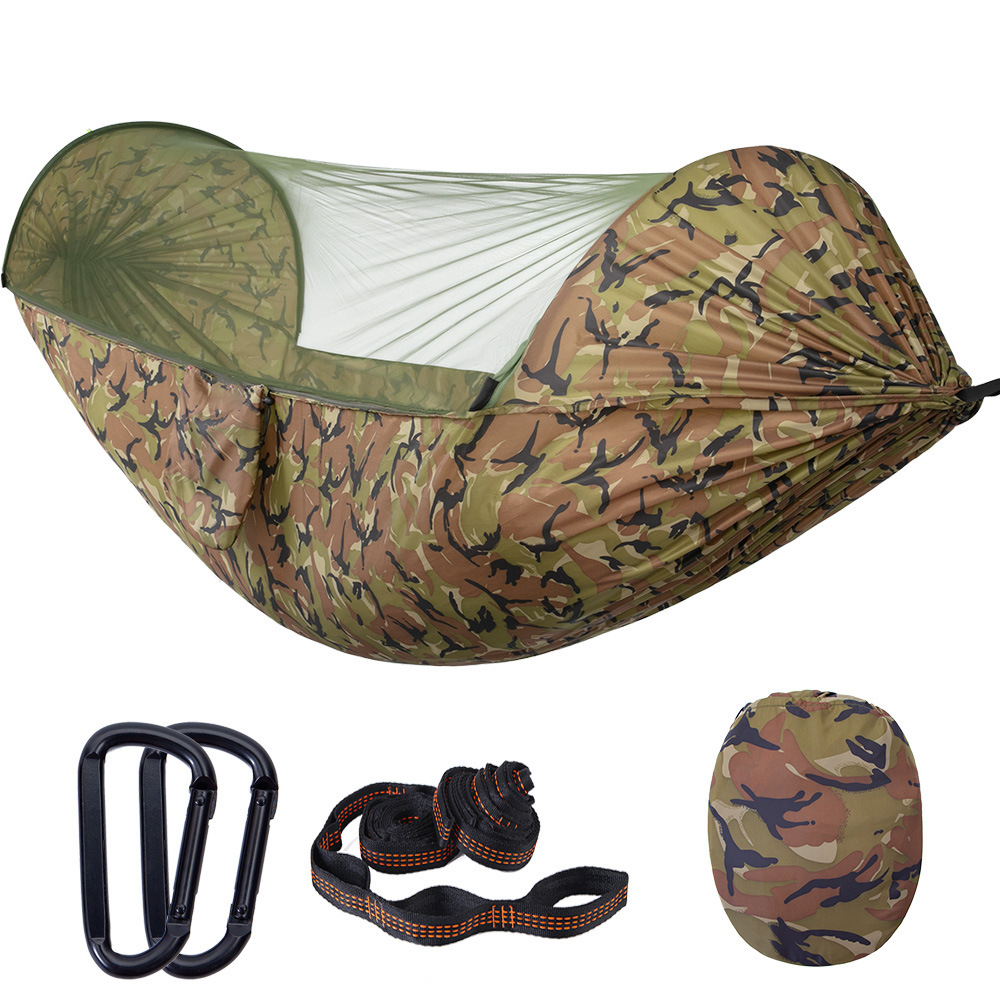In the hustle and bustle of modern life, finding a way to relax and unwind is essential. One such way that has gained immense popularity in recent years is the hammock swing. These delightful swings provide a perfect spot to lounge, read a book, or simply soak in the beauty of nature. However, choosing the right hammock swing can be a bit overwhelming with the myriad of options available in the market. To help you make an informed decision, we’ve compiled a comprehensive guide on the ten crucial things you must consider when choosing a hammock swing.

1. Material Matters
The first and foremost consideration when choosing a hammock swing is the material. Hammock swings are typically made from various materials, including cotton, polyester, nylon, and even canvas. Each material has its own set of advantages and disadvantages. For instance, cotton is soft and breathable but may not be as durable as polyester or nylon, which are more weather-resistant. Consider your climate and intended use when selecting the material.
2. Size and Space
Before making a purchase, measure the available space for your hammock swing. Consider both the length and width required for the swing to fully extend. Ensure that you have enough room to accommodate the swing comfortably without it hitting walls or obstacles.
3. Weight Capacity
Different hammock swings have varying weight capacities. It’s crucial to choose a swing that can safely support the weight of those who will be using it. Be sure to check the manufacturer’s recommendations and opt for a swing that exceeds the weight of the heaviest potential user.
4. Style and Design
Hammock swings come in a wide range of styles and designs. Whether you prefer a bohemian look with fringe and tassels or a sleek, modern design, there’s a hammock swing to match your aesthetic preferences. Consider the overall style of your outdoor or indoor space when making your choice.
5. Suspension System
The method by which you plan to hang your hammock swing is crucial. Some swings come with their suspension systems, while others require separate hardware. Ensure that you have a secure and suitable hanging location, whether it’s from a sturdy tree branch, a ceiling hook, or a purpose-built stand.
6. Comfort and Support
Comfort is paramount when it comes to hammock swings. Look for swings that offer adequate support with comfortable cushions or padding. Consider whether you want a hammock swing with a spreader bar for a flatter, more open position or a cocoon-style swing for a snug embrace.
7. Portability
If you plan to move your hammock swing around or take it on trips, consider its portability. Some swings are lightweight and easy to disassemble, making them ideal for travel, while others are more stationary. Make sure your chosen swing aligns with your mobility needs.
8. Weather Resistance
If your hammock swing will be exposed to the elements, it’s crucial to choose one that is weather-resistant. Look for swings made from materials that can withstand rain, UV rays, and humidity without deteriorating.
9. Maintenance and Durability
Regular maintenance ensures the longevity of your hammock swing. Check if the swing is easy to clean and if replacement parts are readily available. Investing in a durable, long-lasting swing can save you money in the long run.
10. Budget Considerations
Last but not least, consider your budget. Hammock swings come in a wide price range, so it’s essential to find one that aligns with your financial constraints while still meeting your desired criteria.
In conclusion, choosing the perfect hammock swing requires careful consideration of material, size, weight capacity, style, suspension system, comfort, portability, weather resistance, maintenance, and budget. By evaluating these ten crucial factors, you can make an informed decision that ensures countless hours of relaxation and enjoyment.

What Is a Hammock Swing?
Hammock, swing, hammock chair, hammock swing, and swing chair are terms that often come up when discussing these unique pieces of furniture. A hammock swing is essentially a fusion of a traditional hammock and a swing. It typically consists of a suspended seat that allows you to recline comfortably while gently swaying back and forth.
Hammock swings come in various styles and designs, from the classic rope swing to the more intricate macramé hanging chair. They are suitable for both indoor and outdoor use and provide an excellent way to relax and unwind.
Types of Hammock Swings
When it comes to hammock swings, you’ll find a wide variety of styles and materials to choose from. Here are some of the most popular types:
a. Rope Swing Hammocks
Rope swing hammocks are a timeless classic. They are typically made of durable ropes and offer a simple and elegant design. The open construction of rope swings allows for good air circulation, making them ideal for hot summer days.
b. Macramé Hammock Chairs
Macramé hammock chairs are a perfect blend of aesthetics and comfort. These handcrafted swings feature intricate knot patterns and are often adorned with tassels, adding a boho-chic touch to your space.
c. Sensory Swings
Sensory swings are designed to provide therapeutic benefits, making them an excellent choice for children with special needs. They come in various styles and can help with sensory integration and relaxation.
d. Indoor and Outdoor Swings
Some hammock swings are versatile enough to be used both indoors and outdoors. They often come with cushions included, enhancing your comfort whether you’re relaxing on the patio or in your bedroom.
e. Deluxe Swings
Deluxe hammock swings are the epitome of luxury. They often feature extra-large seating areas, UV-resistant cushions, and durable materials, making them perfect for long-term outdoor use.
3. Choosing the Right Hammock Swing for You
When selecting a hammock swing, it’s essential to consider factors such as where you plan to use it, your preferred style, and the level of comfort you desire. Look for features like durable materials, easy installation, and any additional accessories you may need.
4. Setting Up Your Hammock Swing
Setting up a hammock swing is relatively straightforward, but it does require some careful planning. You’ll need a sturdy anchor point, whether it’s a tree branch, porch beam, or a specially designed stand. Ensure that the swing is properly installed to guarantee your safety and comfort.
5. Benefits of Hammock Swings
Hammock swings offer a range of benefits that go beyond relaxation. Some of the key advantages include:
- Stress Relief: The gentle rocking motion of a hammock swing can reduce stress and promote relaxation.
- Improved Sleep: Swinging gently can help improve the quality of your sleep, making hammock swings an excellent addition to your bedroom.
- Enhanced Concentration: Swinging can stimulate brain activity, making hammock swings ideal for children with attention issues.
- Versatility: Hammock swings can be placed in various settings, from your patio to your bedroom, providing a versatile seating option.
6. How to Care for Your Hammock Swing
To ensure the longevity of your hammock swing, it’s essential to follow proper care and maintenance guidelines. Regularly inspect the ropes or fabric for signs of wear and tear, and clean it according to the manufacturer’s instructions.
7. Hammock Swings for Special Needs
For individuals with special needs, sensory swings can be incredibly beneficial. These swings provide sensory integration therapy and can help individuals with autism, ADHD, and other sensory processing disorders. Always consult with a therapist or medical professional to determine the most suitable swing for your specific needs.
8. Top Brands for Quality Hammock Swings
When shopping for a hammock swing, it’s a good idea to choose from reputable brands known for their quality and durability. Some top brands in the hammock swing industry include Jaunty Leisure, Chihee, Boho Swing, and Sensory Swing.
9. Hammock Swing Accessories and Add-Ons
Enhance your hammock swing experience with a range of accessories and add-ons. From additional cushions and pillows to swivels for 360-degree rotation, these extras can make your swing even more enjoyable.
10. Conclusion: Relaxation Redefined
In conclusion, hammock swings offer a unique and relaxing way to unwind and enjoy your leisure time. Whether you’re looking for stress relief, improved sleep, or a versatile seating option, hammock swings have something to offer everyone. With various styles, materials, and accessories to choose from, you can customize your hammock swing to suit your preferences and needs. So, why wait? Dive into the world of hammock swings and redefine relaxation in your own way.
Key Takeaways:
- Hammock swings combine the comfort of a hammock with the gentle sway of a swing.
- There are various types of hammock swings, including rope swings, macramé hammock chairs, and sensory swings.
- Choose a hammock swing that suits your style and needs, considering factors like location and comfort.
- Proper installation and maintenance are essential for the longevity of your hammock swing.
- Hammock swings offer benefits such as stress relief, improved sleep, and enhanced concentration.
- Sensory swings are beneficial for individuals with special needs and sensory processing disorders.
- Look for top brands and consider accessories to enhance your hammock swing experience.
With this comprehensive guide, you’re now well-equipped to embark on your journey to relaxation with a hammock swing that suits your style and preferences. Whether you’re hanging it on your patio, porch, or indoors, your hammock swing will become your go-to spot for unwinding and enjoying the simple pleasures of life.

How to Hang a Hammock Swing Indoors?
Hanging a hammock swing indoors can be a delightful addition to your home, providing a cozy and relaxing spot for lounging. To ensure safety and comfort, follow these steps on how to hang a hammock swing indoors:
Materials You’ll Need:
- Hammock swing with suspension hardware
- Ceiling anchor or support beam
- Drill and appropriate drill bit
- Screw hooks or eye bolts
- Carabiners or S-hooks
- Measuring tape
- Pencil
- Level
Step 1: Choose the Location
- Select a suitable location for your hammock swing. It should have enough space for the swing to move freely without hitting walls or furniture.
Step 2: Locate Ceiling Support
- Identify a ceiling anchor or a support beam where you can safely hang your hammock swing. Using a stud finder can help locate a beam if it’s not readily visible.
Step 3: Measure and Mark
- Measure the distance between the two hanging points on your hammock swing. Mark these points on the ceiling or beam using a pencil. Make sure they are level and equidistant from the centerline.
Step 4: Drill Pilot Holes
- Use a drill and an appropriate drill bit to create pilot holes at the marked points on the ceiling or beam. Make sure the holes are deep enough to securely anchor your hardware.
Step 5: Install Screw Hooks or Eye Bolts
- Screw hooks or eye bolts into the pilot holes. Ensure they are screwed in tightly and securely. These will serve as the anchor points for your hammock swing.
Step 6: Attach Carabiners or S-Hooks
- Attach carabiners or S-hooks to the eye bolts or screw hooks. These will be used to connect your hammock swing to the ceiling anchors.
Step 7: Hang the Hammock Swing
- Hang the hammock swing on the carabiners or S-hooks. Make sure it’s level and balanced. Adjust the height as needed to achieve the desired height from the floor.
Step 8: Test for Safety
- Before using the hammock swing, test it for safety. Gently sit in the swing and ensure that it’s securely attached and doesn’t wobble. Make any necessary adjustments.
Step 9: Final Adjustments
- Once you’re confident in the stability of your hammock swing, make any final adjustments to the height or positioning to ensure comfort and safety.
Step 10: Enjoy Your Hammock Swing
- Your indoor hammock swing is now ready for use. Relax, unwind, and enjoy the comfort and serenity it brings to your indoor space.
Remember to regularly inspect the hardware and connections to ensure they remain secure. With proper installation and maintenance, your indoor hammock swing will provide you with hours of relaxation and enjoyment.
How to Wash Hammock Swing?
Hammock swings are a delightful addition to any outdoor space, providing a perfect spot for relaxation and leisure. However, over time, these swings can accumulate dust, dirt, and stains, making it necessary to give them a good wash. In this guide, we will take you through the steps on how to effectively clean your hammock swing to ensure it remains a comfortable and inviting oasis in your backyard.
1. Gathering Your Supplies
Before you start cleaning your hammock swing, it’s essential to gather all the necessary supplies. You will need:
- Mild detergent
- Soft-bristle brush
- A bucket or basin
- Garden hose
- Clean towels
- Stain remover (if needed)
- Safety goggles and gloves (optional)
2. Removing the Hammock Swing
Take down your hammock swing from its hanging hooks or stand carefully. Make sure you have enough space to spread it out for cleaning.
3. Preparation and Safety
Wear appropriate clothing for the task and consider using safety goggles and gloves, especially if you are dealing with stubborn stains or using chemical stain removers.
4. Cleaning the Fabric
Step 4.1: Brushing Off Debris
Start by gently brushing off any loose dirt, leaves, or debris from the hammock fabric. Use a soft-bristle brush to avoid damaging the material.
Step 4.2: Stain Spotting and Treatment
Inspect the hammock for any stains. If you notice any, treat them with a stain remover as per the manufacturer’s instructions. Be cautious not to use harsh chemicals that might damage the fabric.
Step 4.3: Soaking in Soapy Water
Fill a bucket or basin with lukewarm water and add a mild detergent. Submerge the hammock swing in the soapy water and let it soak for about 15-30 minutes. This will help loosen dirt and grime.
5. Rinsing and Drying
Step 5.1: Thorough Rinsing
After soaking, rinse the hammock thoroughly with a garden hose to remove all the soapy residue. Ensure there are no suds left.
Step 5.2: Drying the Hammock Swing
Lay the hammock swing flat on a clean, dry surface, preferably in the sun. Allow it to air dry completely. Avoid direct sunlight for prolonged periods, as it may cause fading.
6. Inspecting for Damage
While your hammock swing is drying, inspect it for any signs of damage or wear. Check for loose threads, fraying, or weak spots in the fabric. If you find any issues, consider repairing them before reassembling.
7. Reassembling and Rehanging
Once the hammock swing is fully dry and you are satisfied with its condition, reassemble it according to the manufacturer’s instructions. Hang it back in your preferred location.
8. Maintenance Tips
- Regularly brush off debris to prevent dirt buildup.
- Remove and store the hammock swing in a dry place during the winter months.
- Consider using hammock covers to protect it from the elements.
Cleaning your hammock swing is a simple but crucial task to ensure its longevity and comfort. By following these steps and maintaining it properly, you can continue to enjoy relaxing moments in your hammock swing for years to come.
FAQs
- What is the ideal material for a hammock swing?
- The ideal material depends on your specific needs. Cotton is breathable and comfortable, while polyester and nylon offer better durability and weather resistance.
- How do I know the weight capacity of a hammock swing?
- Check the manufacturer’s recommendations and opt for a swing that exceeds the weight of the heaviest potential user.
- Can I use a hammock swing indoors?
- Yes, many hammock swings are suitable for indoor use, provided you have a secure hanging point.
- Are hammock swings easy to clean?
- It depends on the design and material. Some swings are easy to clean, while others may require more effort.
- What is the average lifespan of a hammock swing?
- With proper maintenance, a high-quality hammock swing can last for several years.
Read more:
Hammock Swing Chair Frame Trends: Discover the Latest Styles and Designs

